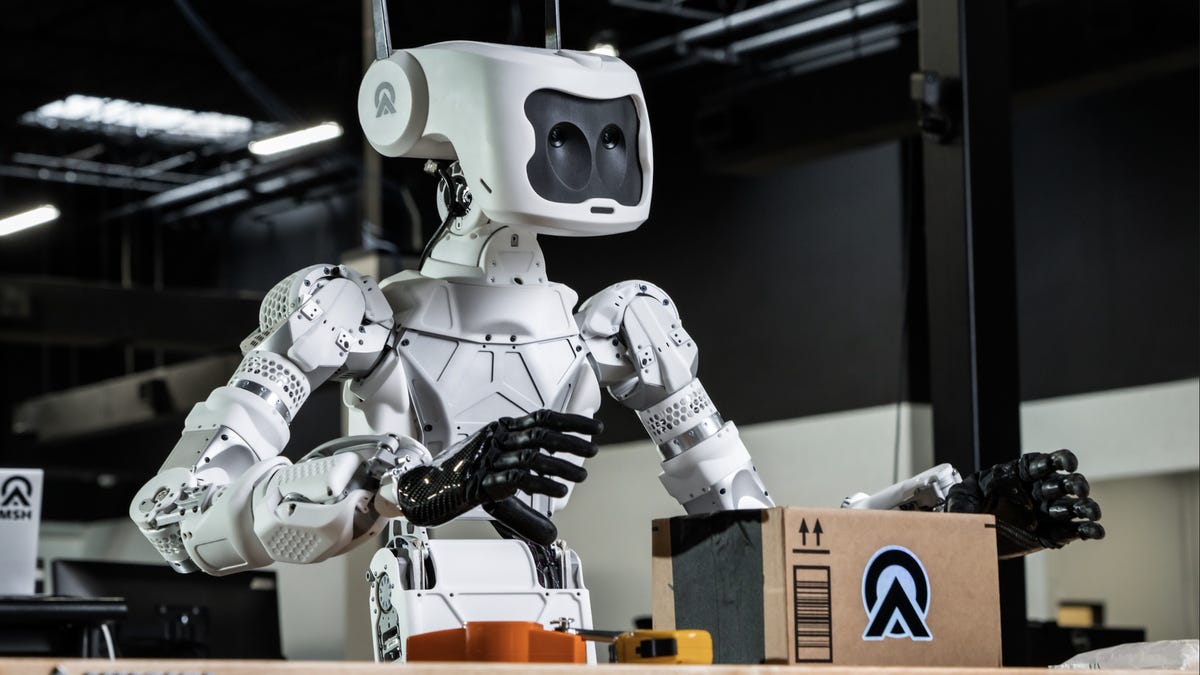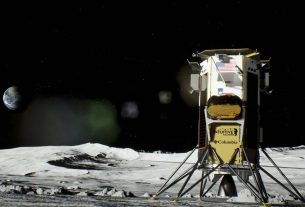Apptronik’s upper body humanoid robot, Astra, is at a work station getting ready to move a package. Image: Apptronik
NASA has a long track record of engineering feats that have helped humans explore the depths of space. One of the agency’s next projects will help humans travel to new celestial bodies – but it may also one day help you do your laundry.
“You know, I’m ready for it. I’m tired of doing my dishes and laundry,” Jeff Cardenas, CEO of Apptronik, tells ZDNET.
Austin-based robotics company Apptronik is working with NASA to create a 5-foot 8-inch, 160-pound, general-purpose humanoid robot named Apollo. The robot is being designed to assist with tasks in space, the commercial sector — and, most interestingly, the home.
Apollo will be equipped to carry out a range of tasks in different environments with the mission of shouldering burdens that humans simply don’t need or want to do.
“The initial things that these robots are going to do are very sort of simple things, like move objects,” Cardenas says. “Things that we’re exerting a lot of energy on, and I think what this will do is free humans up to do things that are much more worthy of our time, and our talent.”
Apptronik’s Valkyrie robot. Image: Apptronik
NASA and Apptronik first worked together in 2013, to build NASA’s Valkyrie Robot during the DARPA Robotics Challenge (DRC). Valkyrie was an all-purpose humanoid robot that could have walked straight out of a sci-fi movie.
As a result of that initial partnership, in September, NASA selected Apptronik as the commercial partner for a new generation of general-purpose robots, starting with Apollo.
The lessons learned from working on Valkyrie are being used to develop humanoid robots that are ready to take on Earth and beyond.
“What we’ve been doing as a company is basically maturing all the technology since Valkyrie to get it ready to commercialize, to move from R&D, to move to the real world,” said Cardenas.
Apollo will make its first debut at South by Southwest in March 2023. Then, for the rest of that year, Apptronik will work closely with select customers to deploy the robot and observe use cases. Broader rollout won’t begin until 2024.
The robot will be utilized in three sectors: commerce, space and personal home use — in that specific order, from structured to unstructured environments.
“Structured means you can control the environment,” Cardenas says. “Unstructured means the environment is very dynamic – and there’s no more dynamic environment than the home, right?”
Before Apollo can become your newest family member, the robot has to be affordable, safe and agile enough to operate in such a dynamic environment.
Home assistance robots have been around for a while, but in much simpler forms and with limited functionality. A Roomba, for instance, is great at cleaning your floors, but you can’t expect it to take out the trash. Meanwhile, commercial spaces such as warehouses deploy entirely different robots, with specific tasks like moving boxes. Building a general-purpose robot like Apollo has, up until now, seemed somewhat implausible.
So why is NASA, an organization dedicated to aeronautics and space, interested in building something that has general-purpose, terrestrial applications? Shaun Azimi, leader of the Dexterous Robotics Team at NASA JSC, says benefiting as many people as possible is part of NASA’s mission.
“One of NASA’s goals is not just to develop technology for space exploration,” said Azimi. “We also want these technologies to be available for use on Earth and that the outcome of the development projects that we undertake with our partners will be available to as many people as possible, to the maximum benefit of humanity in general.”
One major way Apollo will be able to help humanity is by supporting the commercial sector. Apollo will mitigate supply chain issues by doing the jobs that people don’t necessarily want to do but are still vital to sustaining industry and the economy.
Since the pandemic began, there has been a labor shortage in the United States. According to a study by the National Bureau of Economic Research, COVID-19 illnesses have reduced the US labor participation rate by approximately 500,000 workers as of June 2022. This means there is more of a need than ever to fill the gaps – without sidelining the human workforce.
“I don’t expect that we’re going to be replacing people anytime soon,” says Azimi. “But maybe we will have some robots that can assist people, and that’s really what our goal is.”
This holds especially true for robots that will be working on space missions. These robots will be tasked with mundane yet extremely necessary responsibilities, such as maintaining and inspecting equipment.
A major role for Apollo will be setting up bases for sustained presence – human missions on other planets and astronomical bodies, such as the moon or Mars. The robots would get to the planet and set up everything needed for a longer stay before the crew gets there. The key here is that the actual crew remains vital to executing the mission.
Apptronik’s rendering of a future Mars base. Image: Apptronik
“We’re not trying to replace the astronauts, because we don’t believe that we can within the foreseeable future,” says Azimi. “And we don’t know that we really want to, either. It’s really more about freeing up more of their time.”
The Apollo robot development is funded in part by a partnership between NASA, commercial oil and gas company Woodside Energy, and the IWTSD (the Irregular Warfare Technical Support Directorate), a Pentagon office previously known as the CTTSO (Combating Terrorism Technical Support Office).
The ITWSD is supporting the creation of the humanoid robot in order to utilize it for explosive ordnance disposal (EOD) missions that would otherwise put humans at risk. Typically, the people responsible for investigating and approaching explosive devices and IEDs (improvised explosive devices) are humans in bomb suits, which can be a very dangerous activity.
“The focus between NASA and through our partnership with ITWSD is protecting life, and reducing the hazard,” said Azimi. “Whether it’s astronauts that don’t have to go on a dangerous [operation] to repair a damaged piece of equipment, or it’s a bomb technician that doesn’t have to approach a vehicle that has a suspected IED, the purpose is similar, [though] the applications are a little bit different.”
Apollo’s ability to complete tasks in space differentiates it from other humanoid robots that are being developed by competitors.
“Some companies may be developing humanoid robots for terrestrial applications,” says Azimi. “But they’re not necessarily interested in working in the space realm just yet.”
A close competitor is Tesla, which has also been working on a humanoid robot named Optimus, also known as the Tesla bot. Optimus is a 5-foot 8-inch robot that can perform human tasks such as carrying 45 pounds and deadlifting 145 pounds.
Optimus, Tesla’s humanoid robot, walks around the office with a package in hand. Image: Tesla
So why are Tesla’s and Apptronik’s humanoid robots both designed to look like a human? It’s almost like these robots are purposely being designed to resemble the villainous robot characters from a sci-fi movie. The truth is that the robots are shaped as humans so that they can be the most useful in a world that is designed for humans.
“The initial idea here is to build a general-purpose robot that is most useful,” says Cardenas. “If you want a robot that’s going to do work, and it’s going to improve the way we live and work, then having it shaped like a human allows it to use all the same tools and operate in environments built for us.”
If you are still nervous about robots potentially taking over the world, that is totally understandable – Optimus and Apollo aren’t exactly household names, but everyone’s heard of the Terminator. You may take comfort in hearing that, while built to resemble humans, next-generation general purpose robots are still very far from having human intelligence.
The operating systems in these robots use the same deep-learning techniques that power commonplace applications like Siri and Alexa – assistants that don’t exactly have the intelligence to take over the world right now.
“If you’ve ever used a virtual assistant, especially one [with] speech recognition, think about how much it struggles with understanding what you’re trying to ask it to do,” says Azimi. “It’s not like just because you made the robot in the shape of a person, that suddenly it has the intelligence of a person. It still has those same struggles, we’re using those same systems.”
A more pressing concern for Azimi is ensuring that a robotic assistant can reliably perform the task at hand. As anyone who’s interacted with an automated call system knows, Azimi notes, there’s nothing more frustrating than a robot that can’t help you.
“It’s implemented in a way that’s a barrier to the human getting what they need, rather than something that’s actually helping them,” says Azimi.
As Apptronik and NASA ready Apollo for a variety of different environments, it wouldn’t be surprising for more humanoid robots to hit the market.
“I think 10 years, 20 years from now, it’s going to be hard to imagine our lives without robots,” says Cardenas.


